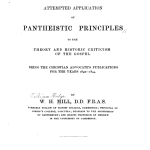
It is very simple to reduce things down to the level of mere matter. Even the finest cello concerto is, from one not very interesting perspective, nothing more than the scratching of cat gut on cat gut. Tolstoy’s War and Peace and Anna Karenina are merely blotches of colored liquid on thin sheets made from rag and wood fiber. The reductionist is merely a transient cell colony, and what we refer to as that cell colony’s reductionist point of view can easily be dismissed as simply a series of intercellular electrochemical transactions.
“We are compelled to admit between the thoughts of a terrestrial astronomer and the behavior of matter several light-years away that particular relation we call truth. But this relation has no meaning at all if we try to make it exist between the matter of the star and the astronomer’s brain, considered as a lump of matter. The brain may be in all sorts of relations to the star no doubt: it is in a spatial relation, and a time relation, and a quantitative relation. But to talk of one bit of matter being true of another seems to be nonsense. It might turn out to be the case that every atom in the universe thought, and thought truly, about every other. But that relation between any two atoms would be something quite distinct from the physical relations between them.”[1]
“If H [his wife, Joy] “is not” then she never was. I mistook a cloud of atoms for a person. There aren’t and never were, any people. Death only reveals the vacuity that was always there. What we call the living are simply those who have not yet been unmasked. All equally bankrupt, but some not yet declared. But this must be nonsense; vacuity revealed to whom? bankruptcy declare to whom? To other boxes of fireworks or clouds of atoms. I will never believe—more strictly I can’t believe—that one set of physical events could be, or make, a mistake about other sets.”[2]
William James quotes M. Taine, from the introduction to this history of English literature: “Whether facts be moral or physical, it makes no matter. They always have their causes. There are causes for ambition, courage, veracity, just as there are for digestion, muscular movement, animal heat. Vice and virtue are products like vitriol and sugar.”[3]
To which James responds, “When we read such proclamations of the intellect bent on showing the existential conditions of absolutely everything, we feel—quite apart from our legitimate impatience at the somewhat ridiculous swagger of the program, in view of what the authors are actually able to perform—menaced and negated in the springs of our innermost life.”[4]
William James eloquently (but not quotably) denouncing the idea that the human religious impulse can be reduced to sexuality.[5]
Medical materialism finishes up Saint Paul by calling his vision on the road to Damascus a discharging lesion of the occipital cortex, he being an epileptic. It snuffs out Saint Teresa as an hysteric, Saint Francis of Assisi as an hereditary degenerate. George Fox’s discontent with the shams of his age and his pining for spiritual veracity, it treats as a symptom of a disordered colon. Carlyle’s organ-tones of misery it accounts for by a gastro-duodenal catarrh. All such mental overtensions, it says, are, when you come to the bottom of the matter, mere affairs of diathesis (auto-intoxications most probably), due to the perverted actions of various glands which physiology will yet discover.
And medical materialism then thinks that the spiritual authority of all such personages is successfully undermined.[6]
[1] C. S. Lewis, “De Futilitate,” in Christian Reflections (Eerdmans, 1967), 63-64.
[2] C. S. Lewis, A Grief Observed, 8-9.
[3] $Cited at James, Varieties of Religious Experience, 9.
[4] $James, Varieties of Religious Experience, 9-10. See also pages 10-13.
[5] $James, Varieties of Religious Experience, note on pages 10-12.
[6] $James, Varieties of Religious Experience, 13.










